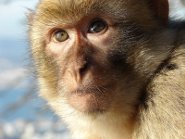 The Barbary macaque (Macaca sylvanus) is a monkey species that primarily inhabits the mountainous regions of Algeria and Morocco. After a small population was introduced into the British territory of Gibraltar, this species also became known as the Barbary Ape. However, this is misleading because the Barbary macaque is a true monkey and not an ape. The populations of these monkeys in Gibraltar are the only primate species, besides humans, to live freely in Europe.
The Barbary macaque (Macaca sylvanus) is a monkey species that primarily inhabits the mountainous regions of Algeria and Morocco. After a small population was introduced into the British territory of Gibraltar, this species also became known as the Barbary Ape. However, this is misleading because the Barbary macaque is a true monkey and not an ape. The populations of these monkeys in Gibraltar are the only primate species, besides humans, to live freely in Europe.As opposed to most species of monkeys, the Barbary macaque has only a stub for a tail. Their fur is brownish-gray across the backs and outer limbs with undersides that are lighter in color. They are medium-sized and heavy built with front limbs that are longer then the rear limbs. Their maximum size is 75 cm (30 in) and they can weigh as much as 13 kg (29 lb). One of their distinguishing features is the almost human-like agility of the front hands, which the population in Gibraltar uses for adeptly picking the pockets of tourists. They walk on all four limbs, but will occasionally rise on their hind limbs to monitor for threats.
Although they were once common throughout all of North Africa and southern Europe, the primary populations of Barbary macaques are now only found in the high plains and mountains of Algeria and Morocco.
Due to their relatively large size as adults and their tight social structure, the Barbary macaque has very few natural predators. Their only major threat is from eagles who will prey upon the young. Unfortunately, the species is listed as endangered due to deforestation of their territories and their systematic extermination by local African farmers who view them as pests. Although they are protected in Gibraltar, the population there is usually kept to less than 250 individuals because of their tendency to cause extensive destruction to human properties and harass tourists for food and trinkets.
Picture of the barbary macaque by RedCoat, licensed under the Creative Commons Attribution-Share Alike 2.5 Generic license.
Keywords: tail
Which zoos have them?
Edinburgh Zoo (United Kingdom)The Barbary ape, barbary macaque is listed as Vulnerable (VU), considered to be facing a high risk of extinction in the wild, on the IUCN Red List of Threatened Species
Some facts about the
Barbary macaque
Adult weight : 10.875 kg (23.925 lbs)
Maximum longevity : 29 years
Female maturity :1399 days
Male maturity : 2007 days
Gestation : 164 days
Weaning : 213 days
Litter size : 2
Litters per year : 1
Interval between litters : 365 days
Weight at birth : 0.45 kg (0.99 lbs)
Weight at weaning : 2.42 kg (5.324 lbs)

Custom Search